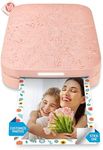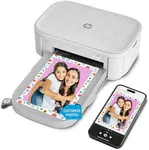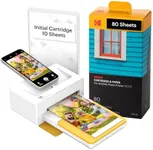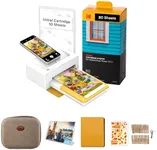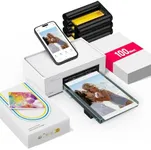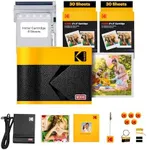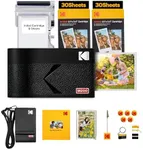Buying Guide for the Best Photo Printer For Iphones
Choosing the right photo printer for your iPhone can greatly enhance your ability to print high-quality photos directly from your device. When selecting a photo printer, it's important to consider several key specifications to ensure you get the best fit for your needs. These specifications will help you understand the printer's capabilities and how well it will perform for your specific requirements.Print Quality (Resolution)Print quality, often measured in dots per inch (DPI), determines the sharpness and detail of the printed photos. Higher DPI values mean better print quality. For casual photo printing, a resolution of 300-600 DPI is usually sufficient. If you want professional-grade prints, look for printers with 1200 DPI or higher. Consider what you will be using the prints for; if they are for personal use or scrapbooking, mid-range DPI should be fine, but for gallery-quality prints, opt for higher DPI.
ConnectivityConnectivity options determine how easily you can print photos from your iPhone. Common connectivity options include Wi-Fi, Bluetooth, and AirPrint. Wi-Fi and Bluetooth allow wireless printing, which is convenient and easy to set up. AirPrint is specifically designed for Apple devices, making it seamless to print directly from your iPhone. If you prefer a hassle-free experience, look for printers with AirPrint compatibility. For more flexibility, choose a printer that supports multiple connectivity options.
Print SpeedPrint speed indicates how quickly a printer can produce a photo. It is usually measured in pages per minute (PPM) or seconds per photo. Faster print speeds are beneficial if you need to print large quantities of photos quickly. For occasional printing, speed may not be as critical, but if you plan to print many photos at once, look for printers with higher PPM or lower seconds per photo. Consider your patience and printing volume when evaluating print speed.
Print SizePrint size refers to the maximum dimensions of the photos the printer can produce. Common print sizes include 4x6 inches, 5x7 inches, and 8x10 inches. Some printers can handle larger formats, while others are limited to smaller sizes. Think about the typical size of photos you want to print. If you mostly print standard-sized photos for albums or frames, a printer that supports 4x6 or 5x7 inches will suffice. For larger prints, ensure the printer can accommodate those dimensions.
Ink TypeInk type affects the quality and longevity of your printed photos. Dye-based inks are known for vibrant colors and are suitable for everyday photo printing. Pigment-based inks offer better durability and resistance to fading, making them ideal for archival-quality prints. Consider how long you want your prints to last and the type of photos you are printing. For high-quality, long-lasting prints, opt for pigment-based inks. For casual, colorful prints, dye-based inks are a good choice.
PortabilityPortability is important if you need to print photos on the go. Portable photo printers are compact and lightweight, making them easy to carry around. They often have built-in batteries for printing without a power source. If you plan to use the printer at home, portability may not be a priority. However, if you want to print photos at events, parties, or while traveling, look for a portable printer that is easy to transport and has a reliable battery life.
Cost of ConsumablesThe cost of consumables includes the price of ink cartridges and photo paper. This can significantly impact the overall cost of using the printer. Some printers have more affordable consumables, while others may be more expensive to maintain. Consider how often you will be printing and your budget for consumables. If you print frequently, look for printers with lower-cost consumables to keep ongoing expenses manageable. For occasional printing, consumable costs may be less of a concern.






